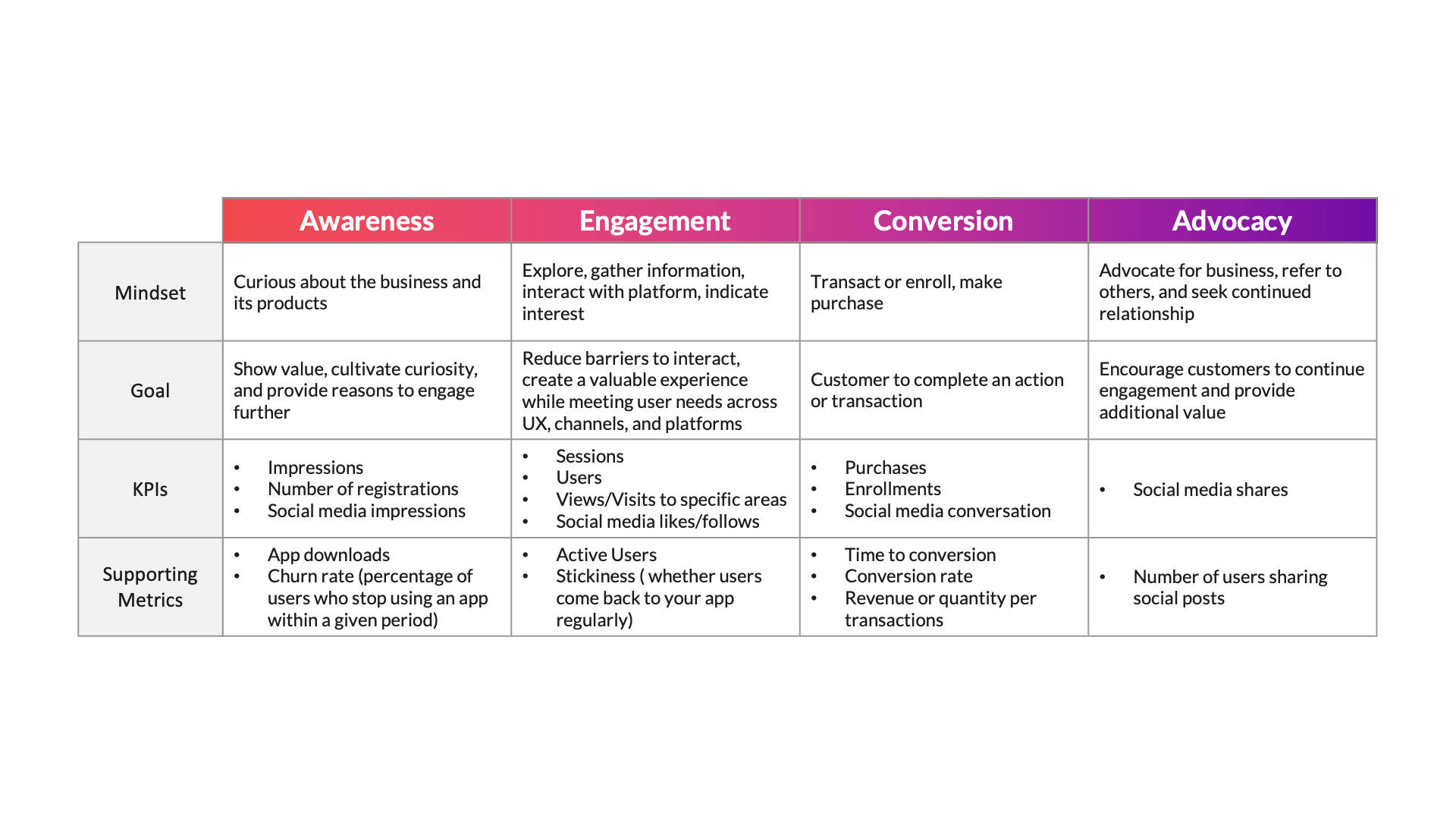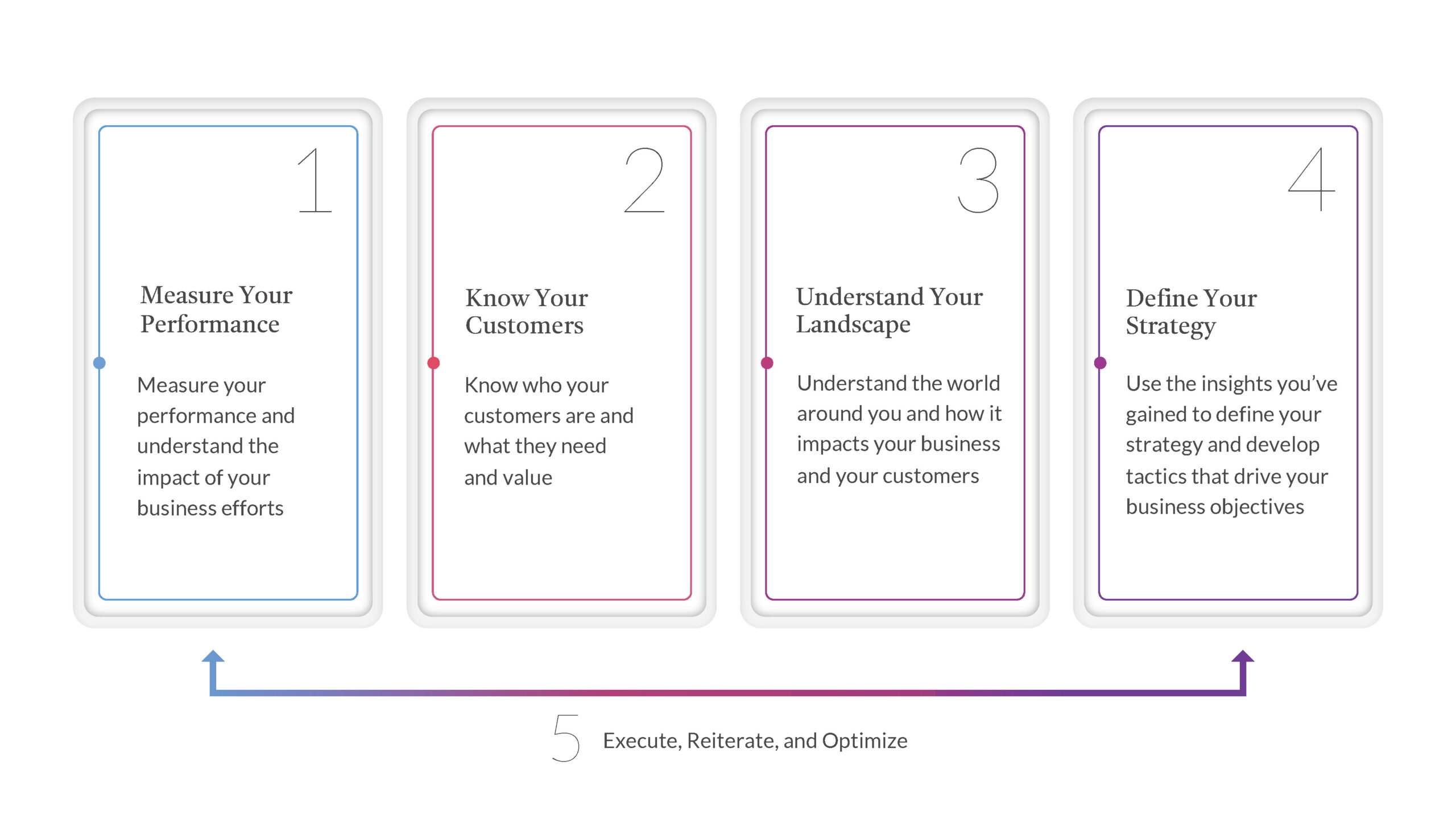06.22.22 By Bridgenext CX Team

With a variety of different digital platforms, channels, and technologies currently available in the world, many businesses confront digital experience strategy with confusion and a hodgepodge approach that is more like throwing spaghetti at a wall than using insightful strategic thinking.
Although it can be both complicated and ambiguous, there are ways to simplify the approach by using business fundamentals to lay the foundation for a solid and well-defined digital experience strategy. The following are five steps to adopt in using analysis and insights to develop a digital strategy.
Think about what efforts your business is currently conducting to meet overall objectives and goals. Key Performance Indicators (KPIs) should be formulated, and their metrics and methodologies developed as a direct reflection of those efforts. KPIs are not only useful for tracking how well the efforts of the business are meeting those goals, but they can also help identify areas where current efforts are not working as well as hoped. From the digital experience perspective, KPIs should focus on how digital assets and activities are performing in meeting both digital and broader objectives.
As strategy and tactics are developed, KPIs should evolve to help measure those efforts. Leveraging KPIs can help determine where you might need to take a deeper analytical dive into certain data points or activities.
An example of a simple digital KPI framework is below.

Leveraging both quantitative metrics and qualitative research allows a better understanding of customers. Surveys, feedback tools, industry and customer analysis, and third-party research are all effective ways to gather information about customers’ needs, behaviors, attitudes, and what they want and value from your business. Look at customers’ journeys through the eyes of different personas and segments to understand which customers are driving the most revenue and through which media, as well as where more value can be added.
Analyzing transactional data and website performance will help improve the UX/UIs and ensure audiences have a cohesive and frictionless experience. This provides customers with what they want, when, where, and how they need it. Finding ways to meet audiences’ needs provides an opportunity to differentiate among competitors.
A landscape analysis is conducted to determine how your business is positioned within the industry among leading competitive and comparable brands/solutions/services. The analysis unveils strengths and weaknesses, industry void “white spaces,” and opportunities for differentiation. Leveraging research tools, like Resonate and Similarweb, will help you stay knowledgeable about the industry, inside and out, as well as any macro- and micro-conditioned economic conditions that may have an impact on business.
Examples of types of research include stakeholder interviews with customers and business stakeholders, industry trend reports, and gathering third-party research to result in insightful data points that can support the strategy.
Equipped with relevant data and insights, a solid understanding of customers and segments, and the competitive and industry landscape, a digital experience strategy can now be formed. A digital strategy should be the blueprint, or road map, in developing and delivering tactics to achieve the defined business goals.
Digital tactics that can drive a strategy include a multitude of channels and platforms that should each be evaluated for effectiveness and return on investment (ROI). These should be evaluated based on the “appropriate channel” to reach the audience and how to best use technology to meet the customers’ needs. These tactics should also be reviewed in conjunction with each other, as there may be collective efficiencies to be gained through aligning some and not others. Prioritize and execute based on the inherent value to the overall strategy, as well as to how well tactics align with each other to ensure a cohesive and congruent customer experience.
Incorporating data and analysis into tactics ensures reaching audiences effectively and relevantly in the appropriate channels. For example, incorporating data enables personalization, which is the cornerstone of data-driven campaigns as consumers continue to vote with their wallets, and provides endless feedback and reviews.
Reiteration is the most critical part of developing and executing a digital experience strategy, because strategic thinking is a continuous process that involves analyzing new data and information, synthesizing learnings, and gaining more insight. The goal is to optimize the strategy as new learnings are obtained and new needs are discovered. Implementing a testing plan against different factors, such as customer behavior, creativity, target audience, and media, allows you to redirect your efforts to those tactics that work best, bringing the most value and ROI back to business.
Continually manage tactical performance to inform of potential updates and shifts in the overall strategy through ongoing analysis reports and research. Understand which tactics and approaches are working (as well as which are not working) to help support and drive any iterative changes back into the overall digital strategy to ensure high performance with the targeted audience.
Well-defined strategies are key to successfully launching campaigns or digital experiences that engage potential customers, drive revenue, build brand awareness, and strengthen the relationship with customers. Leveraging the right tools, information, and holistic thinking, a continuous assessment of business and customers are critical to developing insights to help define an effective data-driven digital strategy. Bridgenext (formerly DEFINITION 6) can help–get in touch with us today to elevate your strategy.
